-
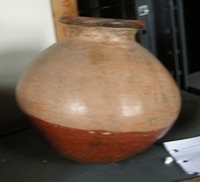 Jar
Jar Someone penciled coordinates on the bottom of this jar, reading “8° 26'N, 82°50'W.” These coordinates lead to a jungle in Panama, likely the place where the jar was first collected. As the object traveled, any paper records associated with it were lost, but the penciled coordinates remained!
-
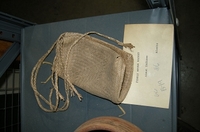 Basket
Basket V. J. Evans purchased this small basket from the Aleut of Alaska before donating it for museum study. The thin handle would have made the basket light and convenient to carry. Today, the basket has dried into a closed position, preventing scholars from opening it to look for secrets inside.
-
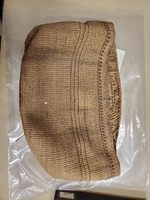 Basket
Basket This Aleut basket is woven with a delicate design of lines and red boxes. This minimal decoration marks the basket, making it identifiable while in use.
-
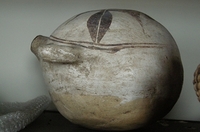 Water carrier's canteen
Water carrier's canteen This canteen is missing its more biodegradable accessories. It originally would have been closed with a corncob plug and carried with a cloth or leather strap tied to the looped handles. Ceramics make for excellent museum objects because they do not degrade in the same way as these organic accessories.
-
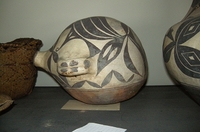 Water canteen: water design
Water canteen: water design This Acoma canteen has the red bottom common to the ceramic type, with a black design on the top that is both geometric and floral. The neck angles towards the decorated side of the canteen, so it can be trusted not to spill water, even when lying down.
-
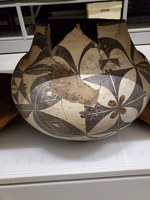 Jar: floral and geometric motif
Jar: floral and geometric motif This jar was collected from Acoma by the Mindeleff brothers, one of whom was in the area for a study of Pueblo architecture. There is significant damage to the rim and base, which possibly occurred during transportation from the Southwest.
-
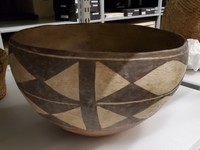 Bowl
Bowl This bowl was collected from Acoma by the Stevensons in 1884 for the Smithsonian Institution and is illustrated in the Smithsonian accession records.
 Jar Someone penciled coordinates on the bottom of this jar, reading “8° 26'N, 82°50'W.” These coordinates lead to a jungle in Panama, likely the place where the jar was first collected. As the object traveled, any paper records associated with it were lost, but the penciled coordinates remained!
Jar Someone penciled coordinates on the bottom of this jar, reading “8° 26'N, 82°50'W.” These coordinates lead to a jungle in Panama, likely the place where the jar was first collected. As the object traveled, any paper records associated with it were lost, but the penciled coordinates remained! Basket V. J. Evans purchased this small basket from the Aleut of Alaska before donating it for museum study. The thin handle would have made the basket light and convenient to carry. Today, the basket has dried into a closed position, preventing scholars from opening it to look for secrets inside.
Basket V. J. Evans purchased this small basket from the Aleut of Alaska before donating it for museum study. The thin handle would have made the basket light and convenient to carry. Today, the basket has dried into a closed position, preventing scholars from opening it to look for secrets inside. Basket This Aleut basket is woven with a delicate design of lines and red boxes. This minimal decoration marks the basket, making it identifiable while in use.
Basket This Aleut basket is woven with a delicate design of lines and red boxes. This minimal decoration marks the basket, making it identifiable while in use. Water carrier's canteen This canteen is missing its more biodegradable accessories. It originally would have been closed with a corncob plug and carried with a cloth or leather strap tied to the looped handles. Ceramics make for excellent museum objects because they do not degrade in the same way as these organic accessories.
Water carrier's canteen This canteen is missing its more biodegradable accessories. It originally would have been closed with a corncob plug and carried with a cloth or leather strap tied to the looped handles. Ceramics make for excellent museum objects because they do not degrade in the same way as these organic accessories. Water canteen: water design This Acoma canteen has the red bottom common to the ceramic type, with a black design on the top that is both geometric and floral. The neck angles towards the decorated side of the canteen, so it can be trusted not to spill water, even when lying down.
Water canteen: water design This Acoma canteen has the red bottom common to the ceramic type, with a black design on the top that is both geometric and floral. The neck angles towards the decorated side of the canteen, so it can be trusted not to spill water, even when lying down. Jar: floral and geometric motif This jar was collected from Acoma by the Mindeleff brothers, one of whom was in the area for a study of Pueblo architecture. There is significant damage to the rim and base, which possibly occurred during transportation from the Southwest.
Jar: floral and geometric motif This jar was collected from Acoma by the Mindeleff brothers, one of whom was in the area for a study of Pueblo architecture. There is significant damage to the rim and base, which possibly occurred during transportation from the Southwest. Bowl This bowl was collected from Acoma by the Stevensons in 1884 for the Smithsonian Institution and is illustrated in the Smithsonian accession records.
Bowl This bowl was collected from Acoma by the Stevensons in 1884 for the Smithsonian Institution and is illustrated in the Smithsonian accession records.